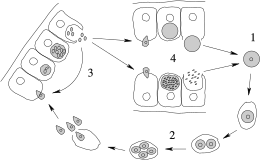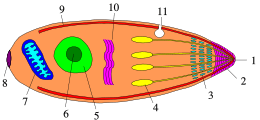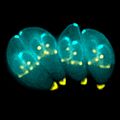Apicomplexa facts for kids
Quick facts for kids Apicomplexa |
|
|---|---|
 |
|
| Scientific classification | |
| Domain: | |
| Kingdom: | |
| Superphylum: | |
| Phylum: |
Apicomplexa
|
| Classes & Subclasses | |
|
|
The Apicomplexa are a big group of tiny, single-celled living things called protists. They are all parasites, meaning they live inside other animals and get their food from them. They have special ways to adapt to this life inside a host. All Apicomplexa are single-celled, live as parasites in animals, and form spores at some point in their life.
These amazing parasites have a special part called an apicoplast, which is a type of plastid. They also have an apical complex, which is a unique structure that helps them get inside a host's cells. Unlike many other tiny organisms, Apicomplexa usually don't have flagella (tail-like structures for swimming) or pseudopods (fake feet for moving) except for some of their reproductive cells. They move by flexing or gliding.
This group was once known as the Sporozoa, but scientists now use the name Apicomplexa.
Apicomplexans have very interesting and often complicated life cycles. There are many differences between the various types of Apicomplexa. They can reproduce in two ways: asexually (by themselves) and sexual reproduction (with another cell). Their cell nuclei contain only one set of chromosomes, meaning they are haploid.
This is a very diverse group that includes many different organisms. Some well-known examples are coccidia, gregarines, piroplasms, and the parasites that cause malaria. Apicomplexan organisms can cause several diseases, such as:
- Babesiosis (caused by Babesia)
- Malaria (caused by Plasmodium)
- Coccidian diseases, which include:
- Cryptosporidiosis (caused by Cryptosporidium parvum)
- Cyclosporiasis (caused by Cyclospora cayetanensis)
- Isosporiasis (caused by Isospora belli)
- Toxoplasmosis (caused by Toxoplasma gondii)
Contents
How Apicomplexa Live and Grow
Most Apicomplexa have a complex life cycle that involves both asexual and sexual reproduction. The parasite infects a host by actively invading its cells. Once inside, the parasites divide to make tiny cells called sporozoites, which then enter other cells.
Eventually, these infected cells burst open, releasing even more tiny cells called merozoites. These merozoites then go on to infect new cells. Later in the cycle, special reproductive cells called gametes are made. These gametes join together to form new cysts, which can then infect a new host. There are many different versions of this basic pattern, and many Apicomplexa can even live in more than one type of host during their life cycle.
The Apical Complex: A Special Tool
The apical complex is a very important part of these parasites. It includes small sacs called vesicles that open at the front of the cell. These sacs release special enzymes that help the parasite break into and enter other cells. The very tip of the parasite is surrounded by a ring of tiny tubes called the polar ring. Some Apicomplexa, like the Conoidasida, also have a funnel-shaped structure made of proteins called the conoid.
The Apicoplast: A Unique Organelle
Many apicomplexan cells contain a single plastid called the apicoplast. This apicoplast is surrounded by three or four membranes. Scientists believe it helps the parasite make important substances like lipids (fats) and haem (a part of blood). The apicoplast seems to be essential for the parasite's survival. It is thought that apicoplasts have a common origin with the chloroplasts found in dinoflagellates, and evidence suggests they came from red algae rather than green algae.
Images for kids
-
Dividing Toxoplasma gondii (Coccidia) parasites
See also
 In Spanish: Apicomplexa para niños
In Spanish: Apicomplexa para niños







